Whether you’re a fan of Crush from Finding Nemo, or you simply love all of the amazing creatures that live in the great blue beyond, it’s clear that sea turtles are some of the most fascinating animals on the planet.
These stunning turtles are incredibly well-adapted to life in our planet’s oceans. But how much do you know about the 7 types of sea turtles that swim in our salty seas?
Up next, we’ll take a closer look at the 7 types of sea turtles. We’ll give you a quick overview at each of these wonderful sea-faring reptiles and we’ll give you insight into how these turtles are classified. To wrap things up, we’ll even offer you some super sea turtle fun facts so you can impress all your friends with your turtle know-how.
Sea Turtle Classification
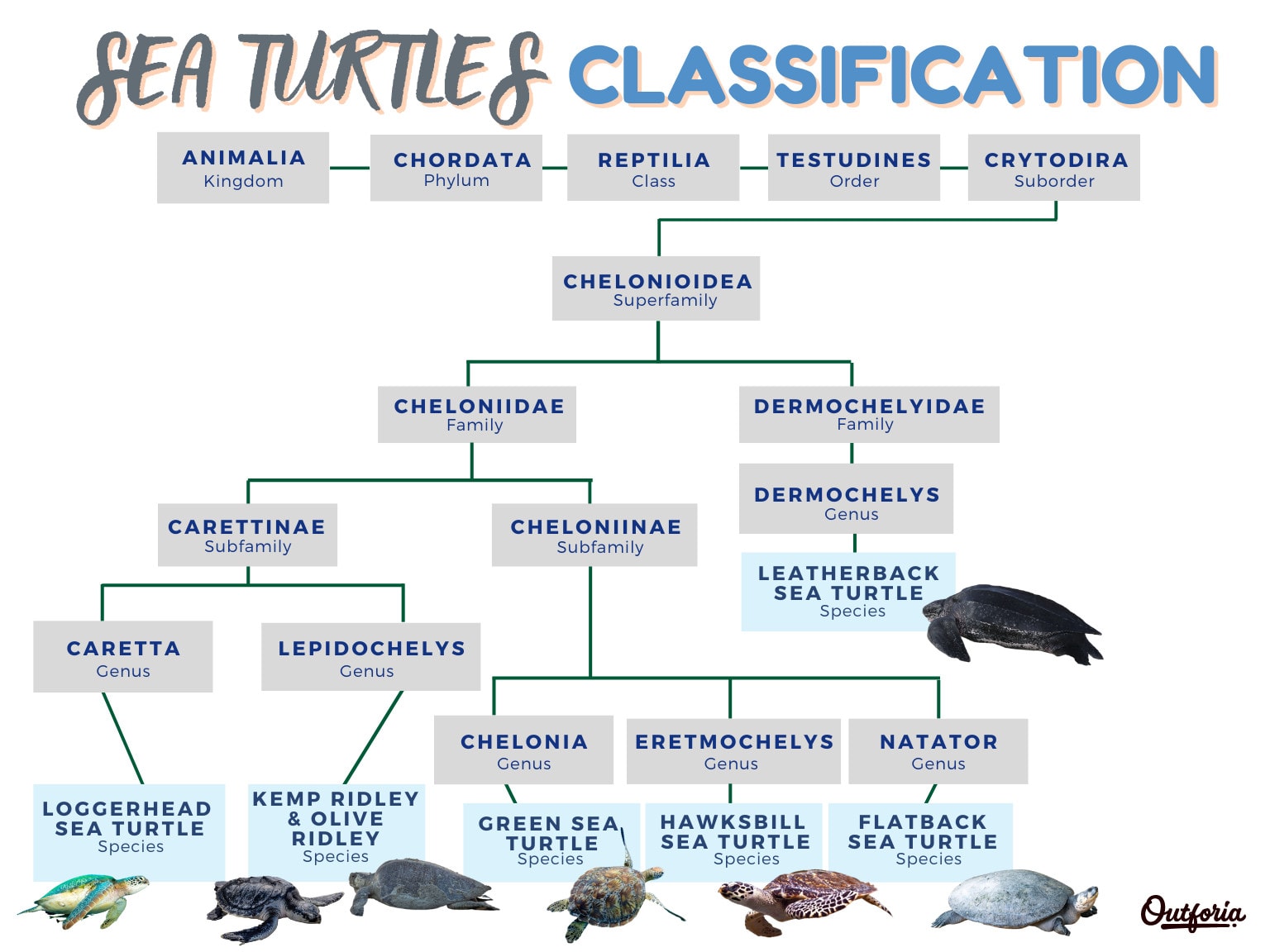
All 7 species of sea turtles are part of the kingdom Animalia, the phylum Chordata, and the class Reptilia. This means that all sea turtles are reptiles, just like crocodiles, snakes, and lizards.
Below the class Reptilia, all sea turtles are part of the order Testudines. This includes all of the turtles, which are defined as reptiles with shells that develop out of their ribs. The order Testudines also includes all of the animals that we might commonly refer to as tortoises and terrapins.
This is where things start to get a bit confusing.
Within the order Testudines, sea turtles are part of the suborder Cryptodira. The word ‘cryptodira’ comes from the Greek and means ‘hidden neck.’ This order includes most of the living turtles and tortoises. It is closely related to the suborder Pleurodira, or the ‘side necks,’ which contain just a small fraction of all the turtle species on the planet.
Below the suborder Cryptodira, all sea turtles are part of the clade Americhelydia. This clade contains a number of superfamilies and subclades, including snapping turtles, mud turtles, and sea turtles.
Moving down even further on the phylogenetic tree, all sea turtles are part of the clade Panchelonioidea. This clade primarily contains sea turtles and a handful of other extinct, yet related taxa.
All sea turtles are then found in the superfamily Chelonioidea. This superfamily contains two extant (living) families: Cheloniidae and Dermochelyidae.
All but 1 of the 7 types of sea turtles are classified in the family Cheloniidae. The leatherback sea turtle is the only living member of the family Dermochelyidae.
Last but not least, within the family Cheloniidae, we have two subfamilies: Carettinae and Cheloniinae.
The subfamily Carettinae contains the genus Caretta (loggerhead sea turtle) and the genus Lepidochelys (Kemp’s ridley and olive ridley sea turtles). Meanwhile, the subfamily Cheloniinae contains the genus Chelonia (green sea turtle), the genus Eretmochelys (hawksbill sea turtle), and the genus Natator (flatback sea turtle).
You may also like: How Long Do Sea Turtles Live? All About Their Best Kept Secret
7 Types of Sea Turtles Species with Scientific Names and Photos
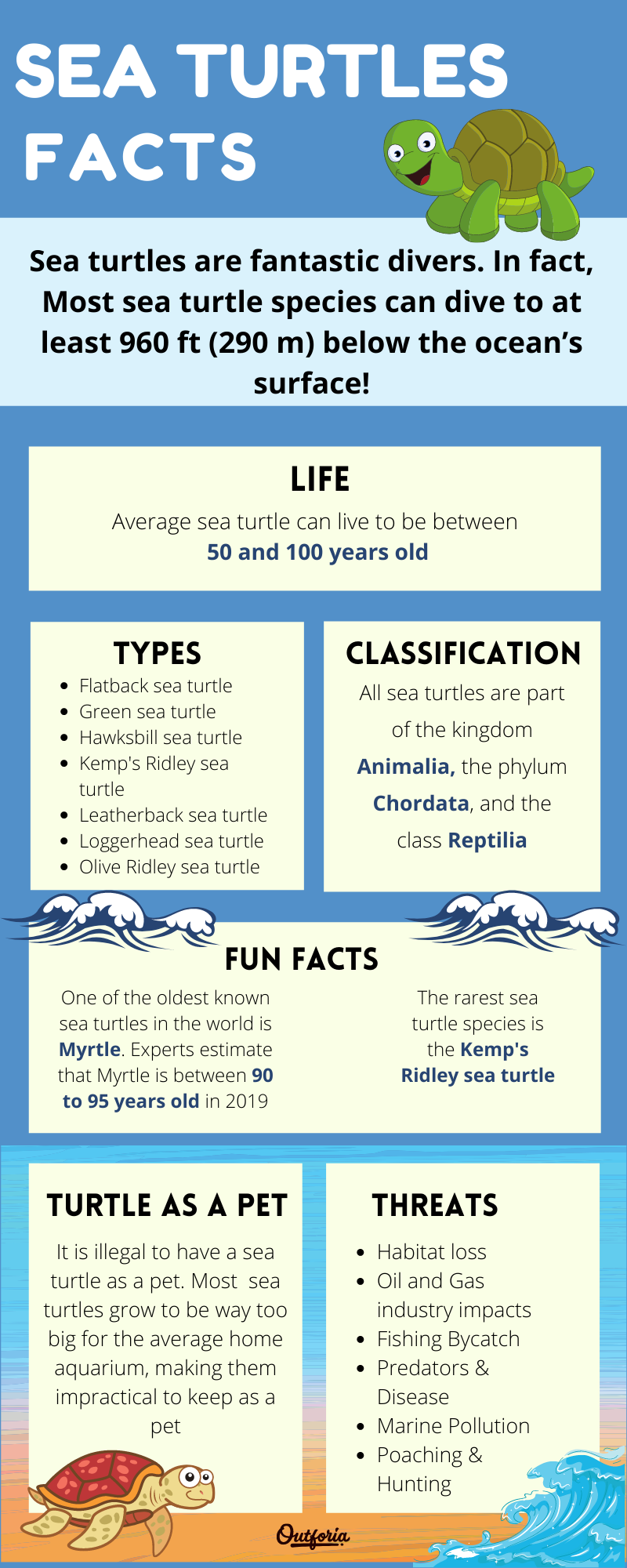
Share This Image On Your Site
<a href="https://outforia.com/types-of-sea-turtles/"><img style="width:100%;" src="https://outforia.com/wp-content/uploads/2021/10/SEA-TURTLES-INFOGRAPHIC.png"></a><br> Types of Sea Turtles Infographic by <a href="https://outforia.com">Outforia</a>Although there are more than 300 different types of turtles on our planet, only 7 species can be classified as sea turtles. Here’s what you need to know about each species:
1. Flatback Sea Turtle (Natator depressa)
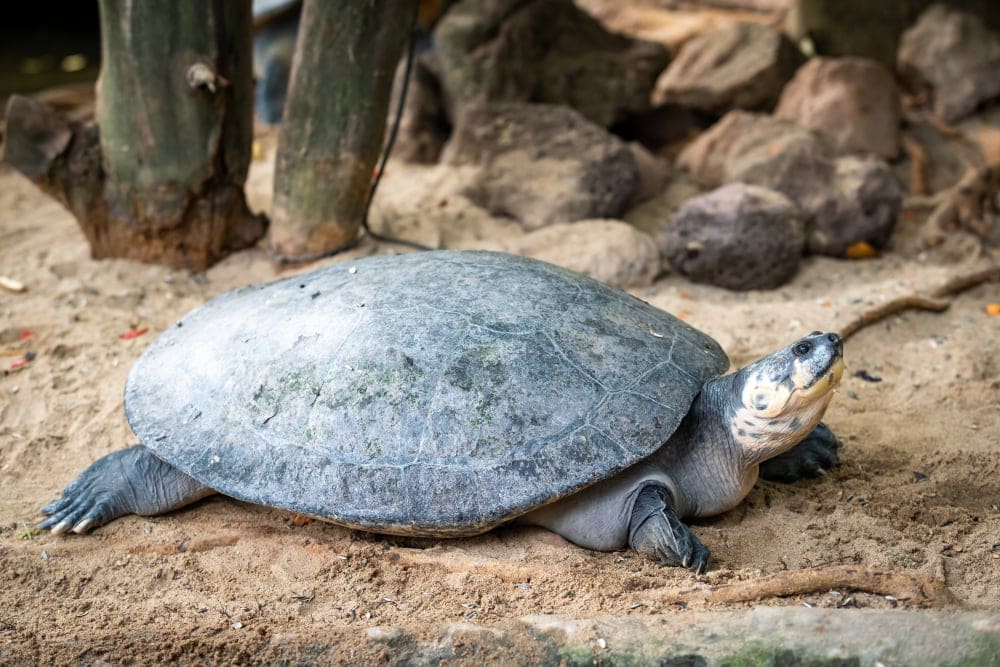
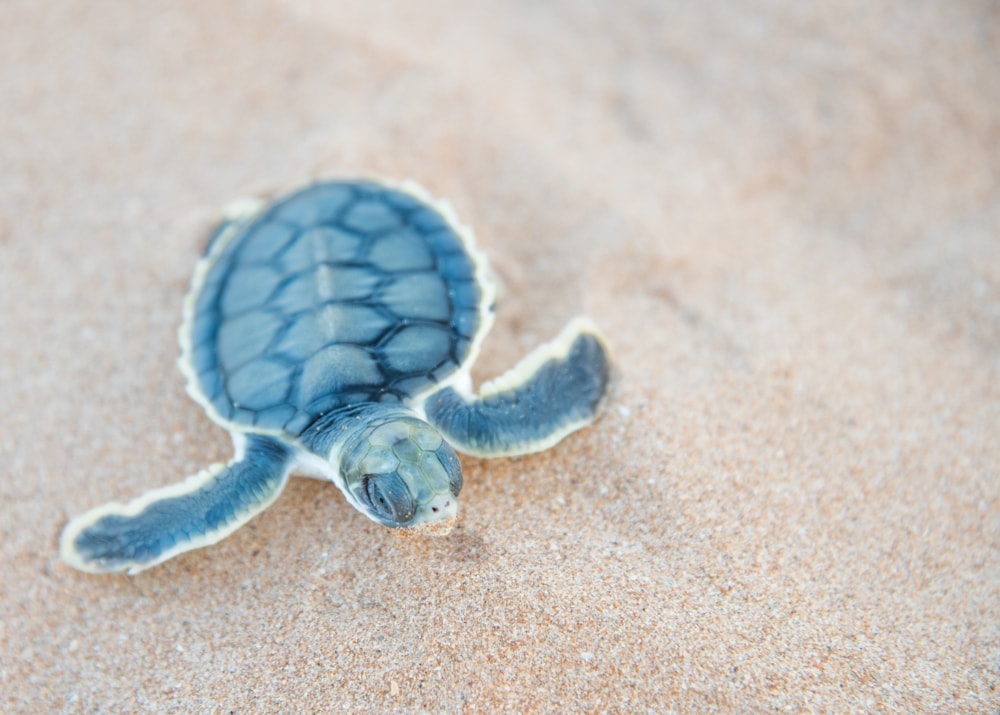
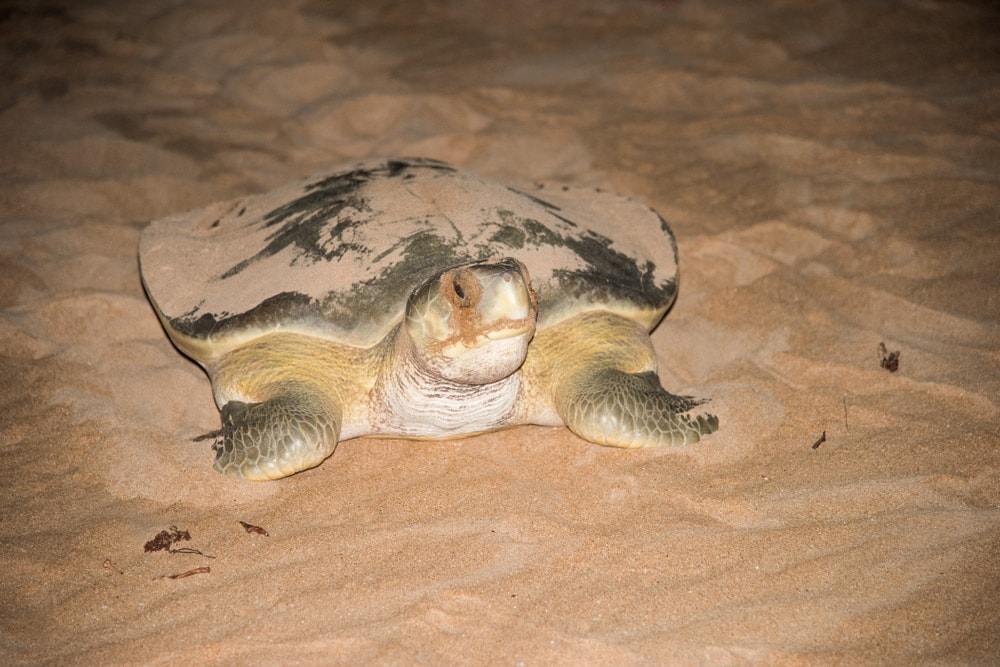
Also known as the Australian flatback sea turtle, the flatback sea turtle (Natator depressus) is a sea-faring reptile that lives solely along the sandy beaches and coastal waters in and around Australia. The flatback actually has the smallest geographic range of any sea turtle species. There are only a handful of flatback nesting sites throughout Australasia.
As its name suggests, the flatback sea turtle has a relatively flat shell. It’s a medium-sized turtle that’s usually no more than about 37 inches (94 cm) long and 220 lbs (100 kg) in weight. However, flatback sea turtle hatchlings tend to be larger than the hatchlings of other species when they first leave their eggs.
Unlike other sea turtle species, the flatback isn’t listed as endangered. However, this is simply because the IUCN (International Union for the Conservation of Nature) lists the flatback as “data deficient,” which means that there isn’t enough information available to understand the species’ population trends.
Despite this, the flatback is at risk due to habitat loss, accidental bycatch, pollution, and the illegal collection of its eggs. While Indigenous peoples in Australia are legally allowed to harvest the flatback sea turtle’s eggs, it is illegal for others to do so.
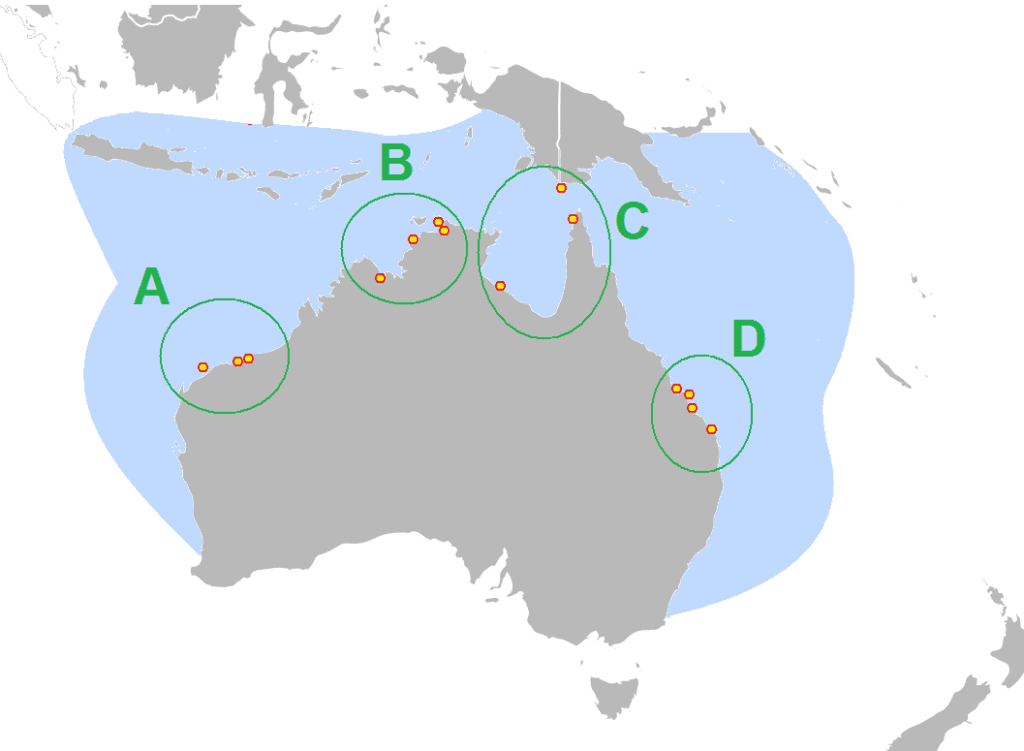
cc by-sa 4.0 / b kimmel / wikimedia commons
2. Green Sea Turtle (Chelonia mydas)
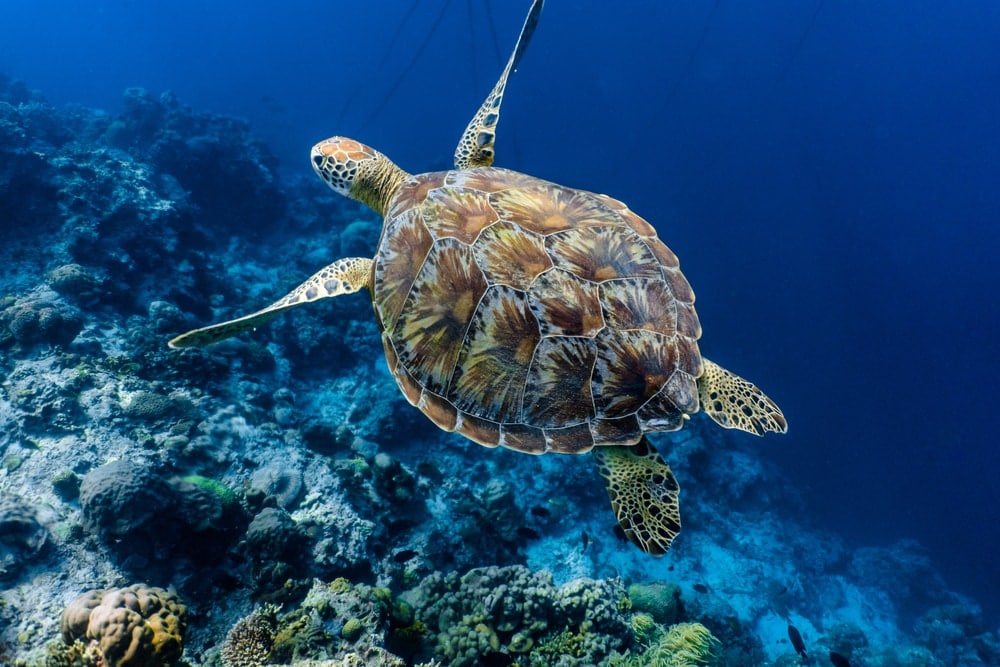
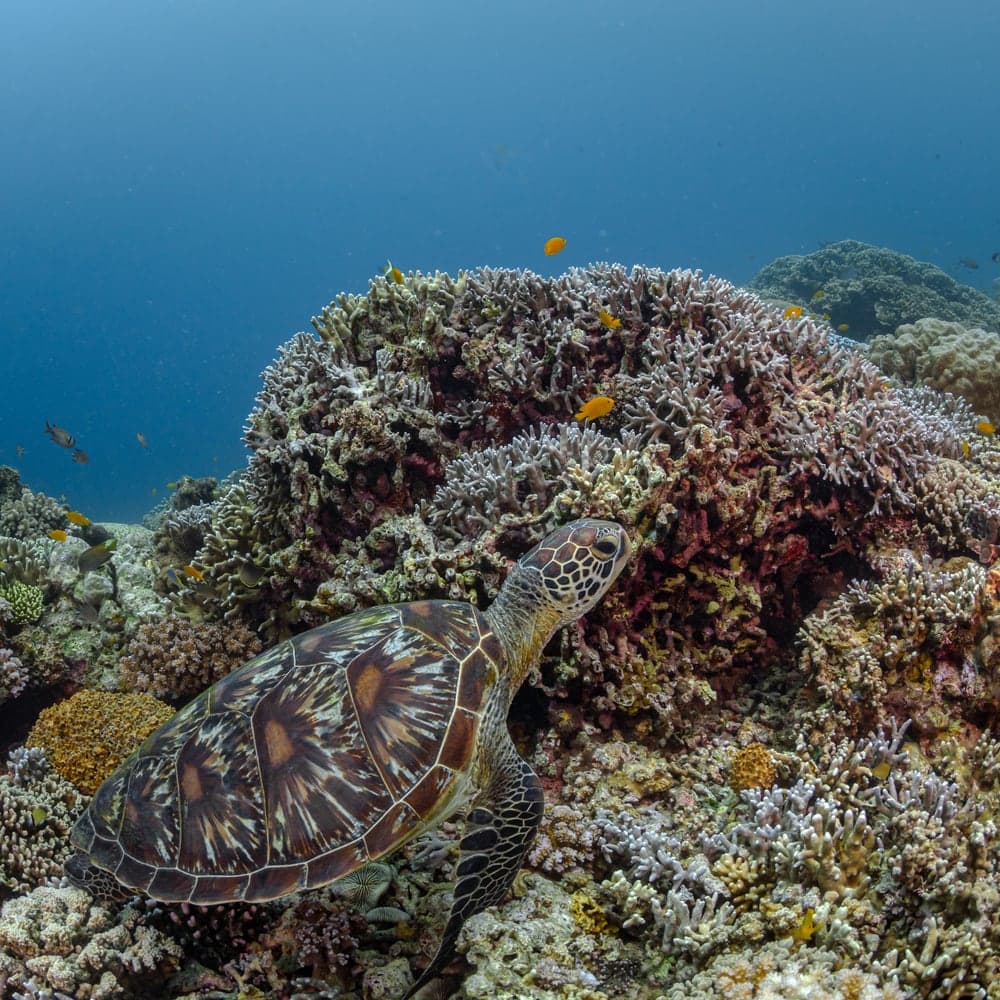
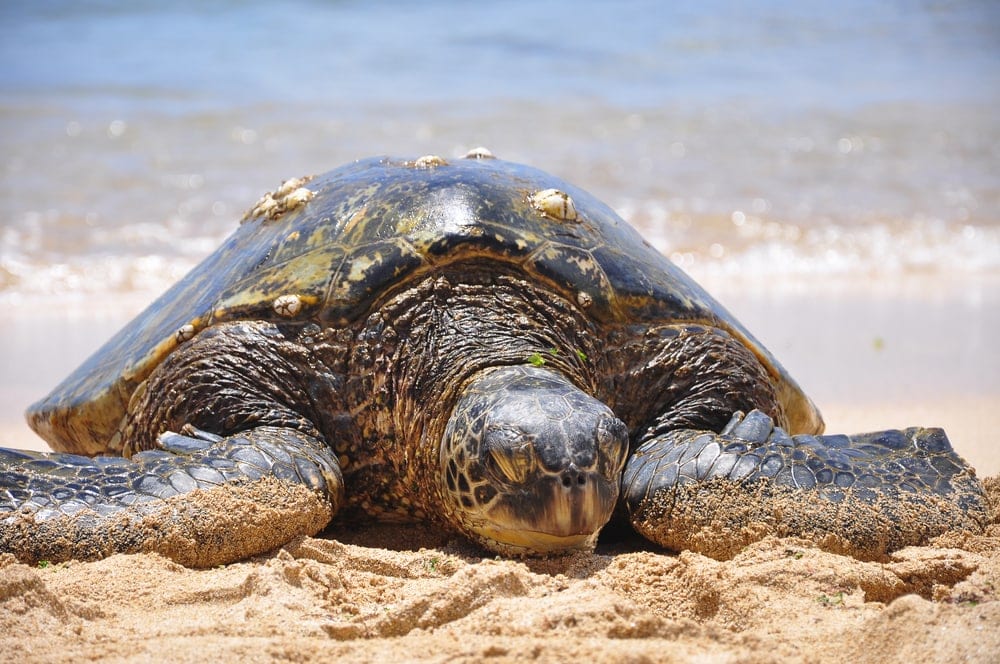
Arguably the best-known sea turtle species, the green sea turtle (Chelonia mydas) is a large marine reptile that lives throughout subtropical and tropical waters. Its range is primarily in the Pacific and Atlantic oceans, however, it’s often found in the Indian Ocean, too.
The green sea turtle gets its name from the greenish color of the fat that’s found beneath its carapace (the top of a turtle’s shell). It’s primarily an herbivore, so you’ll normally find green sea turtles feeding on seagrasses in shallow lagoons.
Green sea turtles also have one of the longest migrations of any sea turtle species. Some are known to travel more than 1,600 mi (2,600 km) between their feeding and nesting areas. Most of these turtles seek out sandy beaches in warmer waters to breed. Additionally, many green sea turtles will venture back to the beach where they hatched from in order to lay their own eggs.
The green sea turtle is currently listed as endangered by the IUCN, and its population is decreasing worldwide. Its primary threats are residential and commercial development, climate change, and accidental bycatch by the fishing industry.
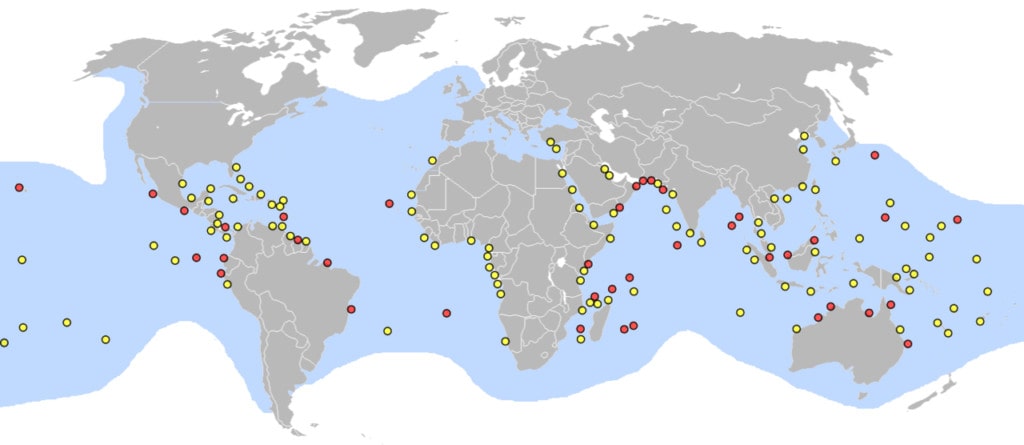
cc by-sa 3.0 / pinpin / wikimedia commons
3. Hawksbill Sea Turtle (Eretmochelys imbricata)
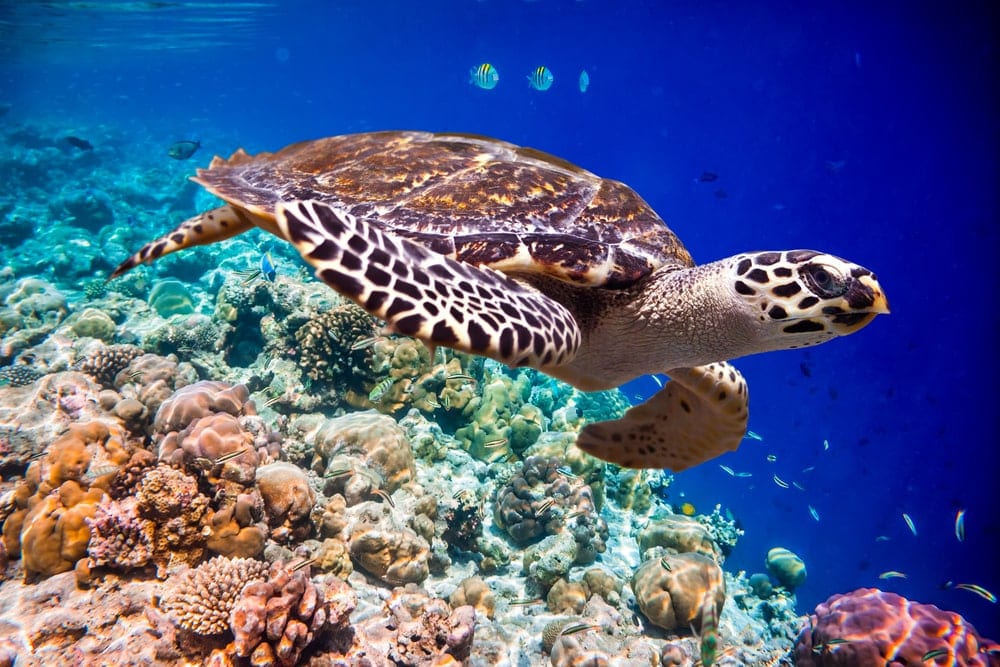
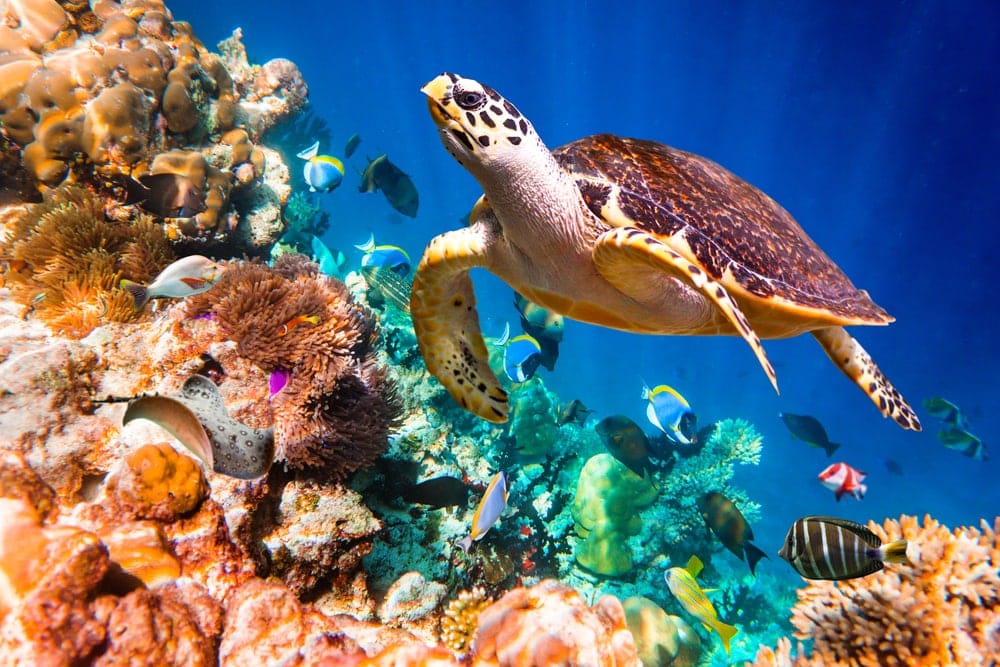
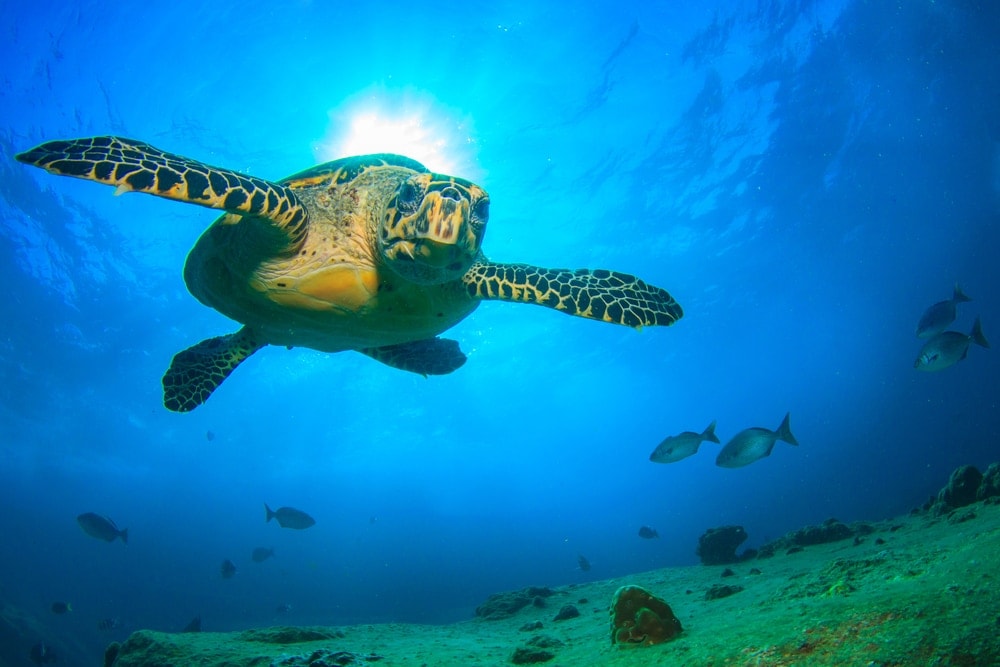
The hawksbill sea turtle (Eretmochelys imbricata) is a fascinating sea turtle that’s found in coral reefs, coastal waters, and open oceans around the world. It has two recognized subspecies—one that lives in the Indo-Pacific, and one that lives in the Atlantic.
Aptly named, the hawksbill has a unique beak shape that looks surprisingly like that of a hawk. It has a prominent tomium, which is the cutting edge of a bird or turtle’s beak. This tomium is essential for the hawksbill because it uses its sharp beak to forage for its favorite food: sea sponges.
The hawksbill is listed as critically endangered by the IUCN, mostly due to habitat loss that’s caused by residential and commercial development as well as oil and gas drilling. Pollution and fishing industry bycatch are also major threats to the long-term health of the hawksbill sea turtle species.
However, the hawksbill is also particularly vulnerable to human-related exploitation. Although some hawksbill deaths are accidents, others are poached for their meat, eggs, and shells. Nevertheless, it is illegal to hunt these turtles in most countries, though some allowances are made for subsistence hunting by Indigenous peoples.
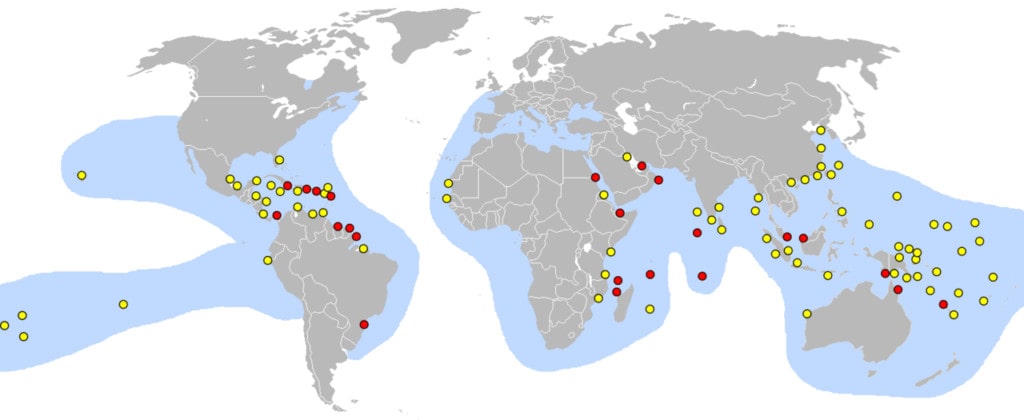
cc by-sa 3.0 / pinpin / wikimedia commons
4. Kemp’s Ridley Sea Turtle (Lepidochelys kempii)
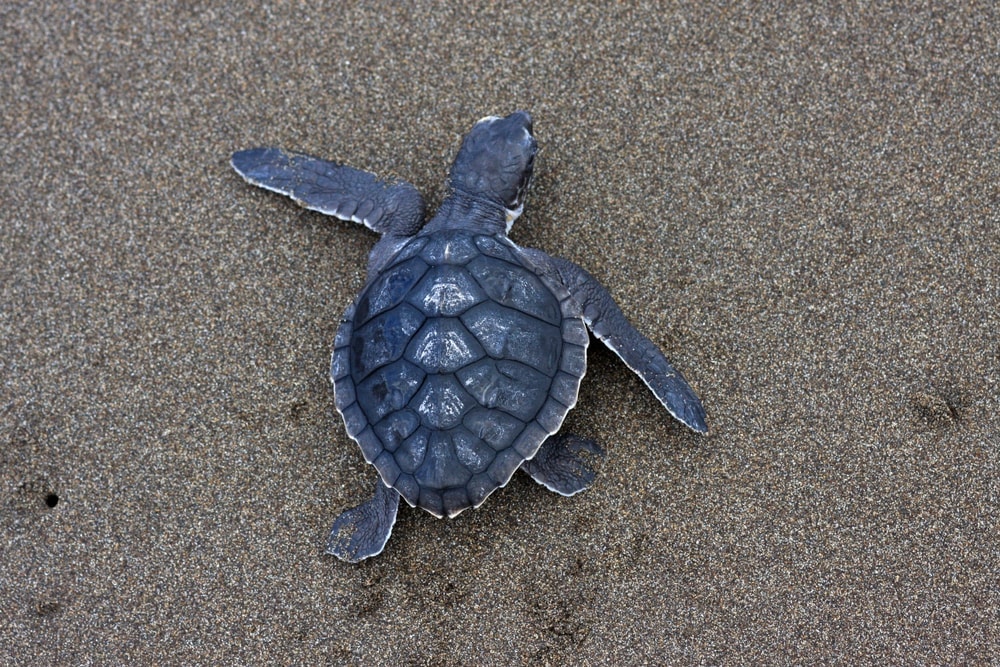
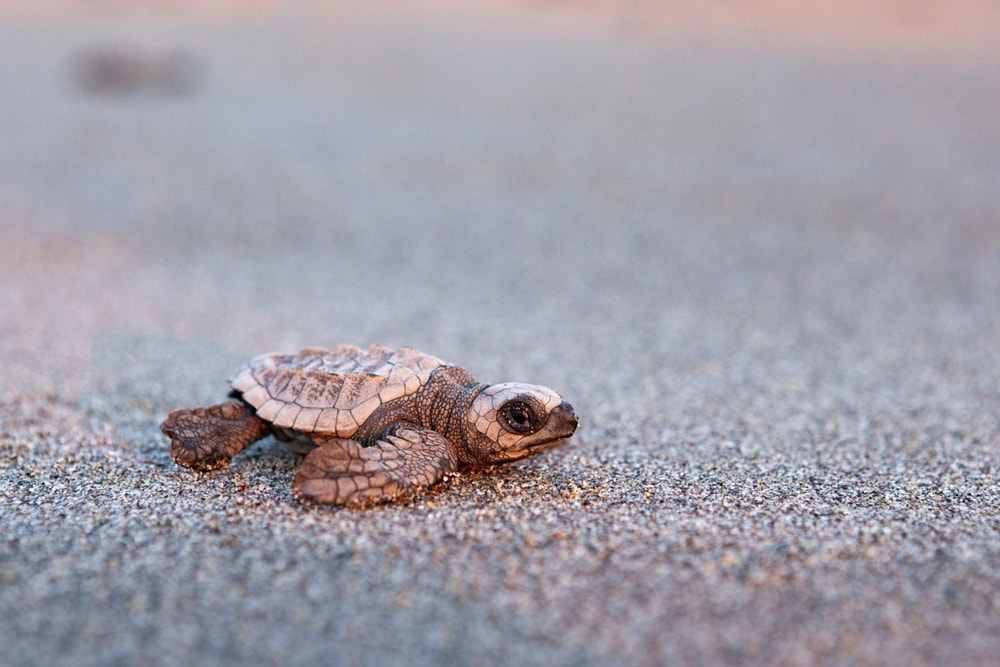
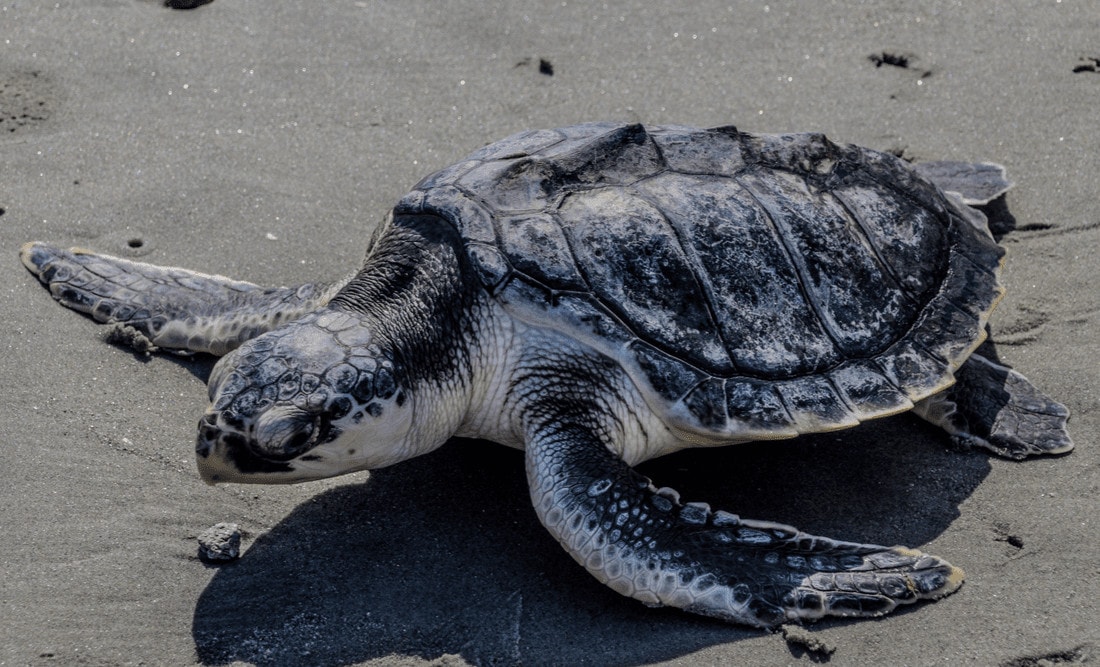
Arguably the rarest sea turtle species, the Kemp’s ridley sea turtle ( Lepidochelys kempii ) is a small marine reptile that lives only in the Atlantic Ocean. It’s primarily found in the Gulf of Mexico, though juveniles and vagrants have been spotted as far away as Malta, Ireland, and northern Newfoundland.
The Kemp’s ridley sea turtle gets its common name from that of Richard Moore Kemp, who sent one of the first species of the species to Harvard for research. It is closely related to the olive ridley sea turtle, but it’s not clear where the term ‘ridley’ comes from.
In addition to being the rarest sea turtle, the Kemp’s ridley is also the smallest sea turtle. It generally weighs less than about 100 lbs (45 kg) and rarely grows to be larger than 28 inches (70 cm) in length.
Additionally, the Kemp’s ridley sea turtle is the only known sea turtle to nest during the day. All other species lay their eggs at night, which helps protect the eggs from predators, like birds and foxes.
The IUCN currently lists the Kemp’s ridley sea turtle as critically endangered. Its primary threat is oil and gas drilling, but it also suffers from a lack of food due to overfishing in Atlantic waters. Conservation efforts are underway to protect the Kemp’s ridley in the US and Mexico, however, oil spills in the Gulf of Mexico are a major threat to the species.
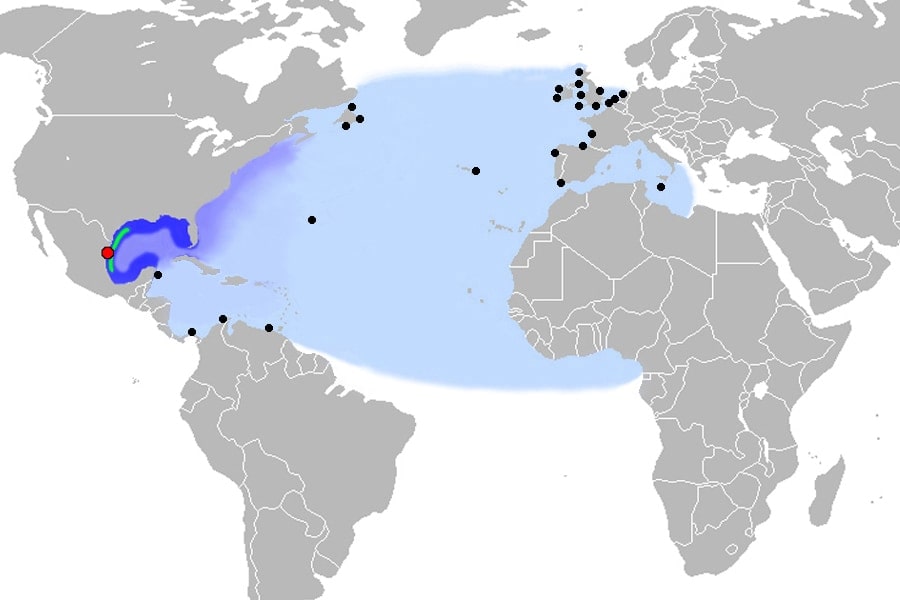
cc by-sa 4.0 / william l. farr / wikimedia commons
5. Leatherback Sea Turtle (Dermochelys coriacea)
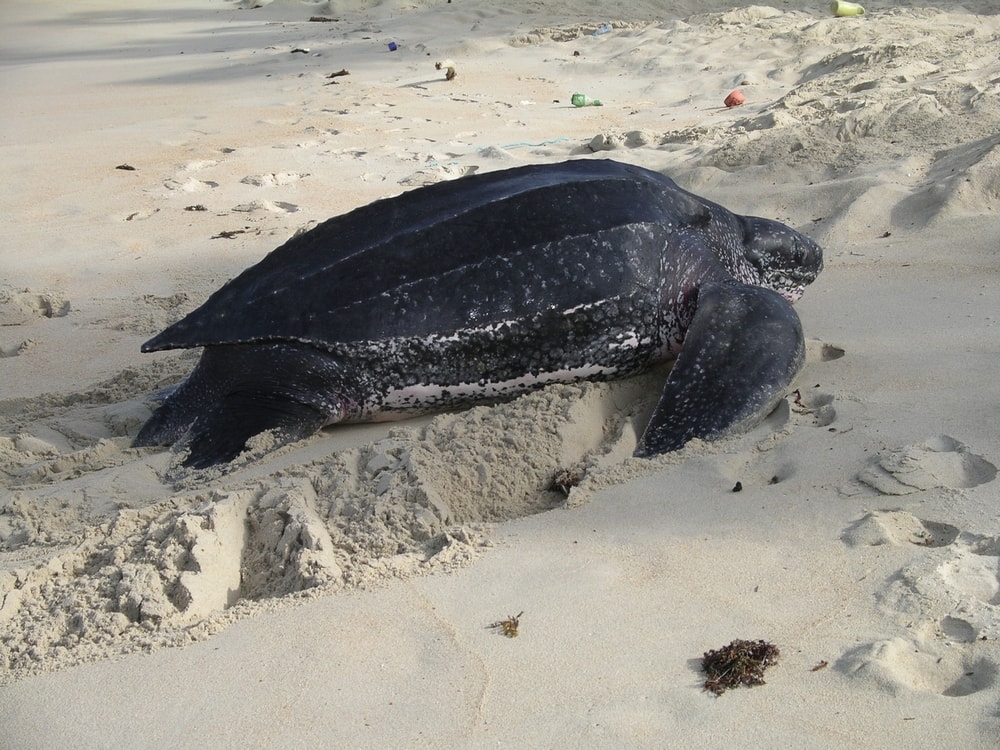
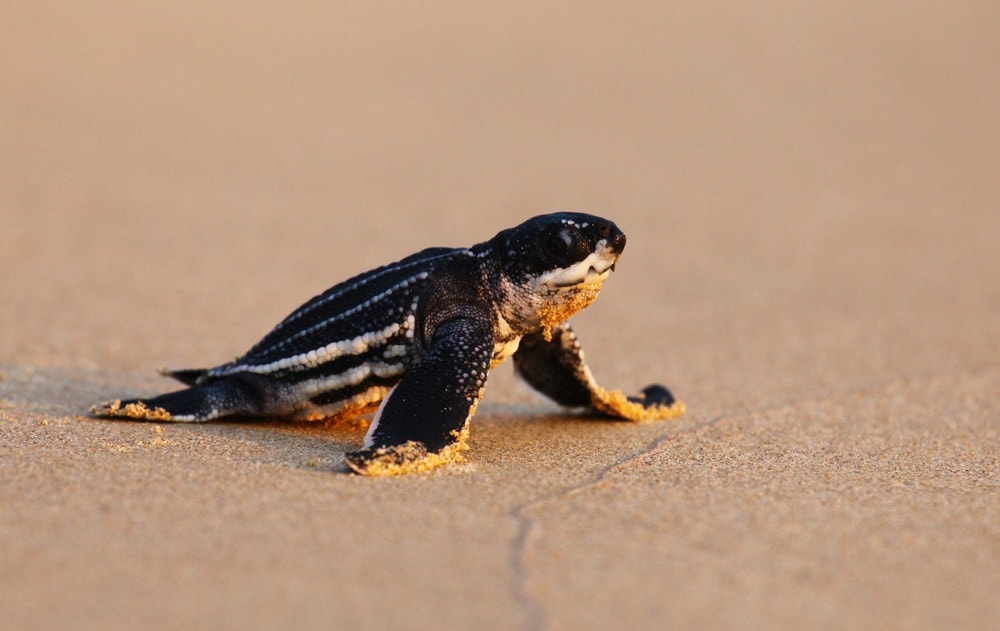
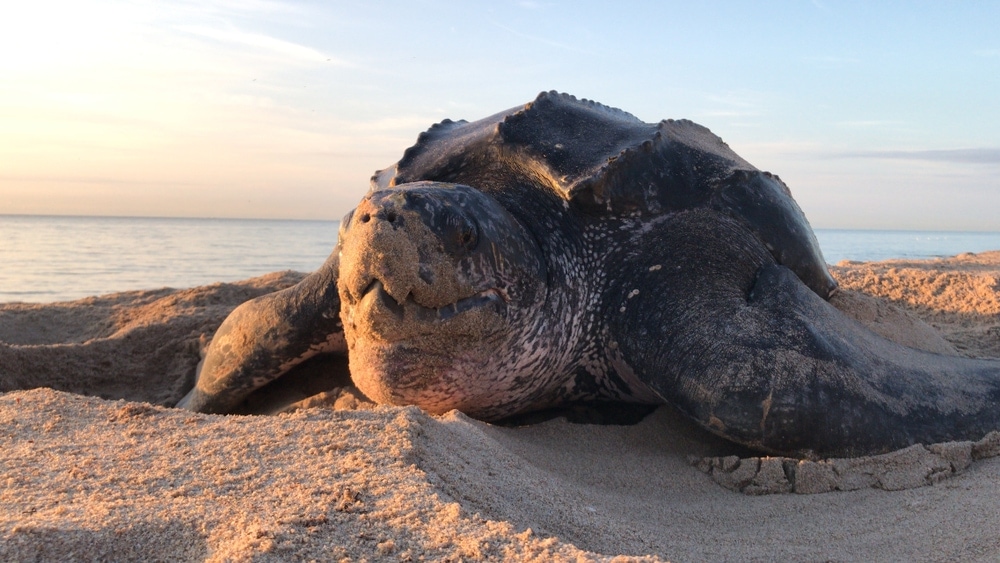
The only sea turtle that’s not a member of the family Cheloniidae, the leatherback sea turtle (Dermochelys coriacea) is a massive reptile that lives in oceans around the world. It’s found in nearly all tropical and subtropical waters as well as in parts of the Arctic Ocean.
Among sea turtles, the leatherback is unique in many ways. First and foremost, it’s the largest living sea turtle with a maximum weight of about 2,000 lbs (907 kg). This makes it the largest non-crocodilian reptile in the world.
Second, the leatherback sea turtle doesn’t have a bony shell. Rather, the aptly named leatherback has a shell that consists of an oily leather-like skin that’s highly pliable. The pliability of this shell is important because it can contract when the turtle dives to protect it from high pressure deep in the ocean.
Leatherbacks also seem to have a unique ability to produce body heat, which isn’t common among reptiles. Researchers don’t know exactly how leatherbacks manage to pull off this feat, but it might be a result of its unusually high levels of physical activity.
The leatherback is also one of the fastest-moving reptiles in the world with a maximum swimming speed of about 22 mph (35 km/h). Who would’ve thought that such a large turtle could move so fast?
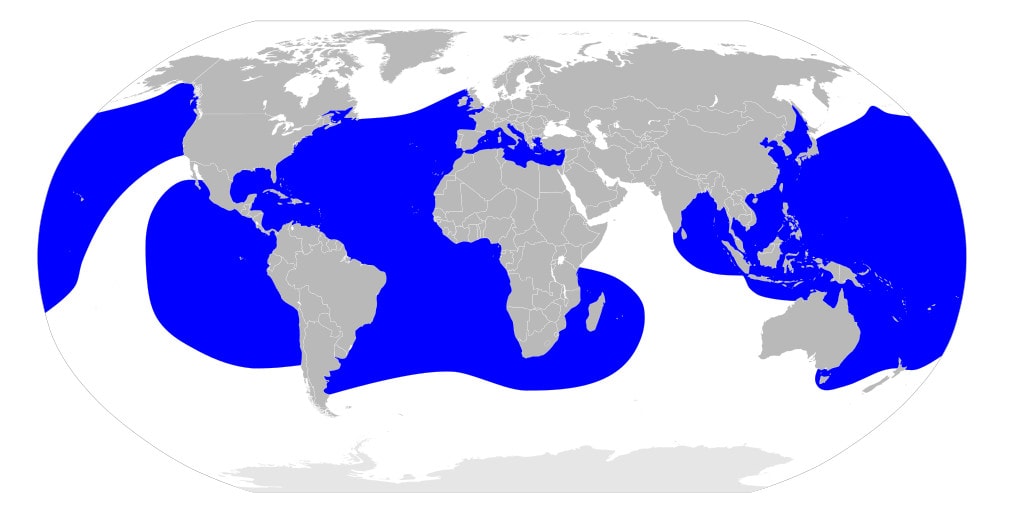
cc by-sa 4.0 / Wallace, B.P., Tiwari, M. & Girondot, M / wikimedia commons
6. Loggerhead Sea Turtle (Caretta caretta)
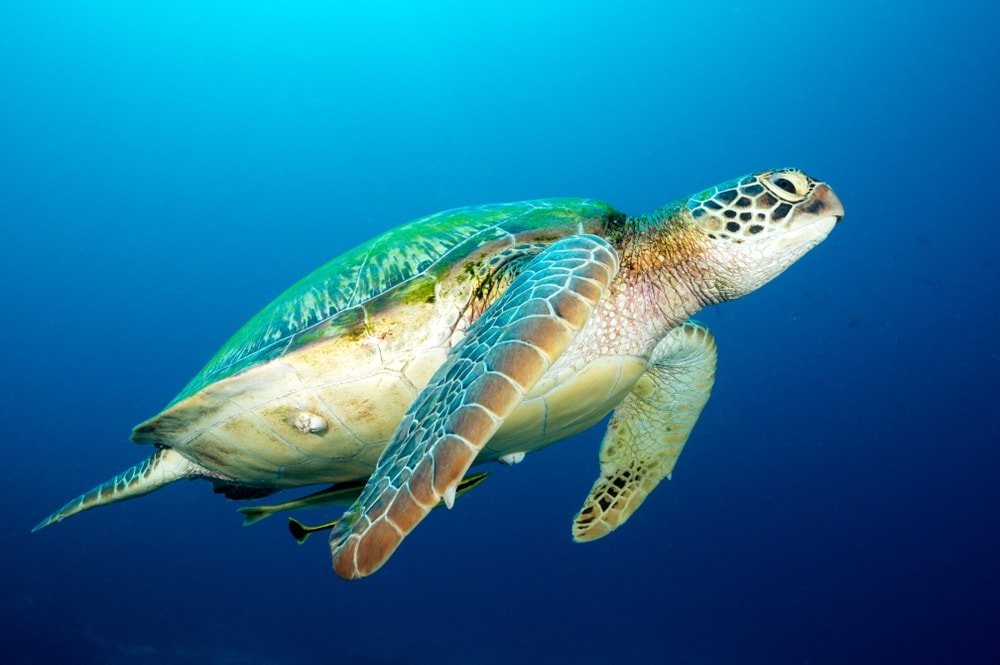
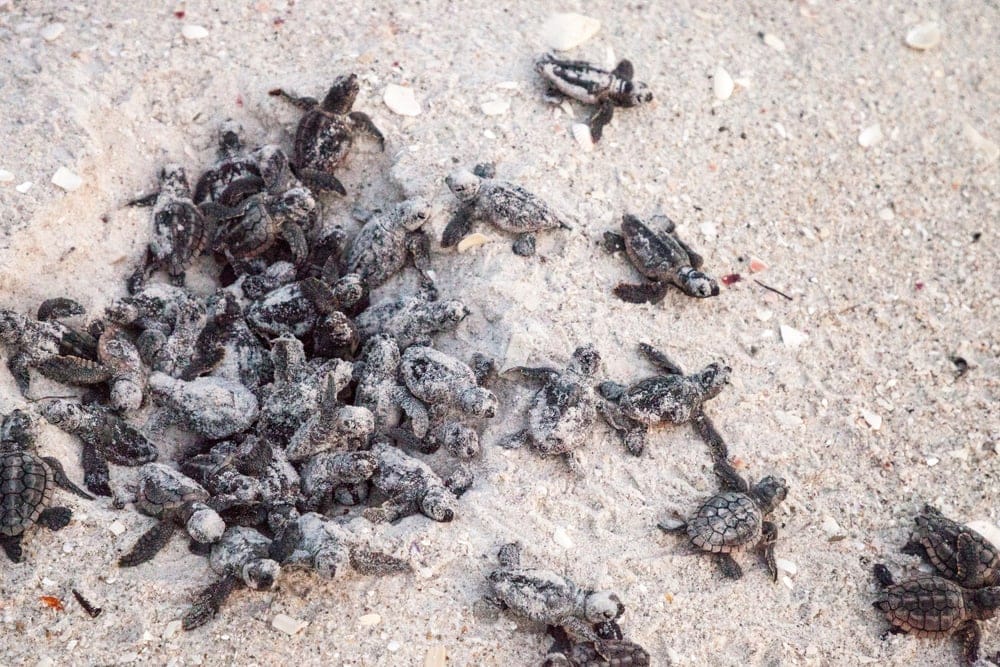
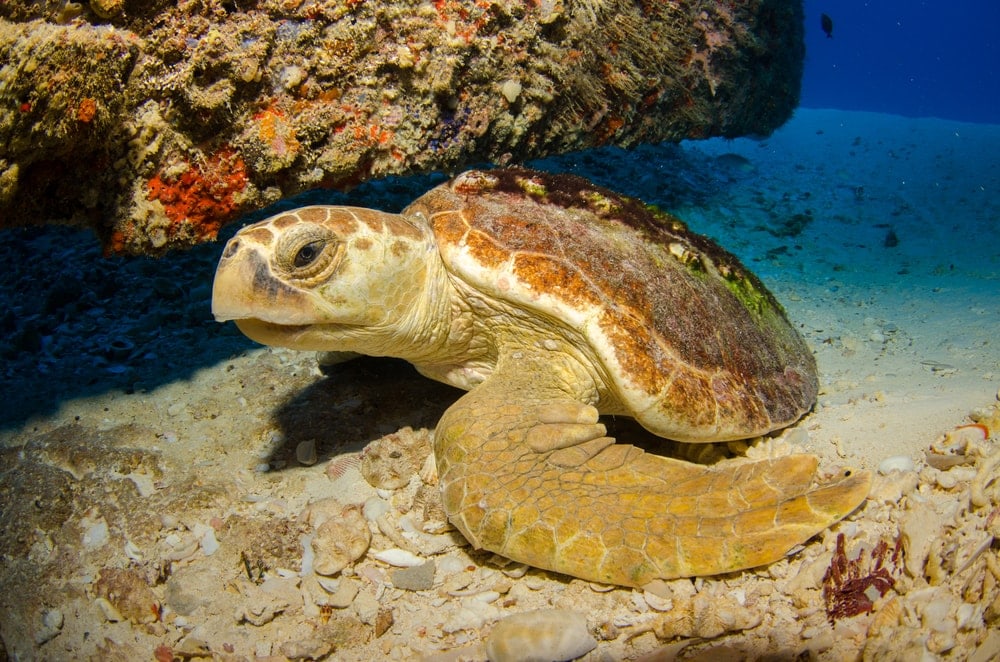
The loggerhead sea turtle (Caretta caretta) is a relatively large ocean-dwelling reptile that lives primarily in coastal waters and around salty estuaries. It has what’s known as a cosmopolitan distribution, which means that it lives pretty much everywhere on Earth where there’s a suitable habitat.
Loggerheads are omnivorous turtles, so they’ll eat everything from sponges and corals to sea cucumbers, Portuguese men o’war, and starfish. They have very powerful jaws that let them eat a wide variety of prey. Plus, loggerheads have a funky set of scales on their forelimbs that can act as a set of pseudo-claws for ripping apart food.
Due to the loggerhead’s large size, it doesn’t have many natural predators in adulthood. The species is listed as vulnerable by the IUCN and its population is declining worldwide.
As is the case with most other sea turtles, residential and commercial development, as well as fishing bycatch, are the primary threats to the loggerhead. It’s also legal to hunt the loggerhead in some countries. But, there are many conservation programs, particularly in the US, that close tourist beaches each year to protect the loggerhead sea turtle during the nesting season.
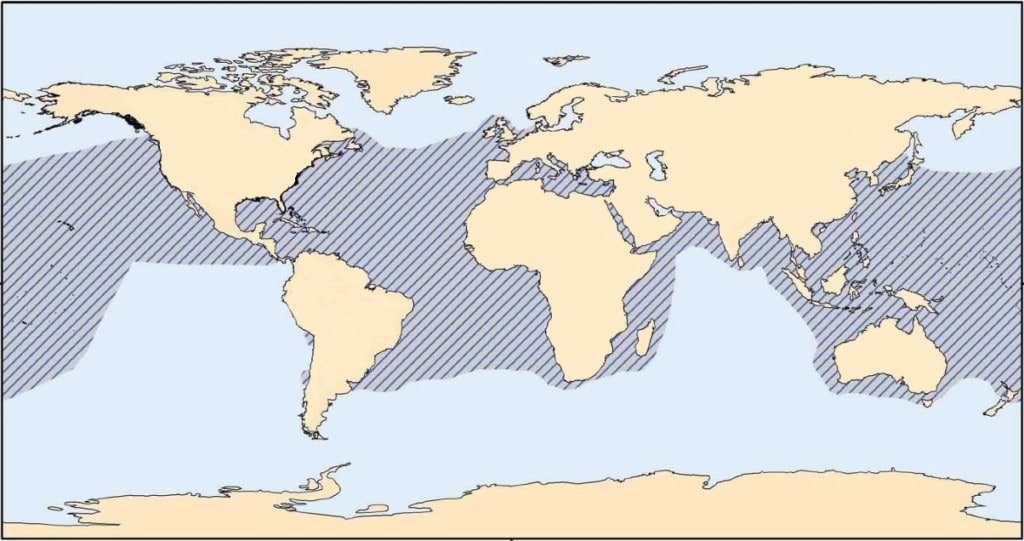
public domain / wikimedia commons
7. Olive Ridley Sea Turtle (Lepidochelys olivacea)
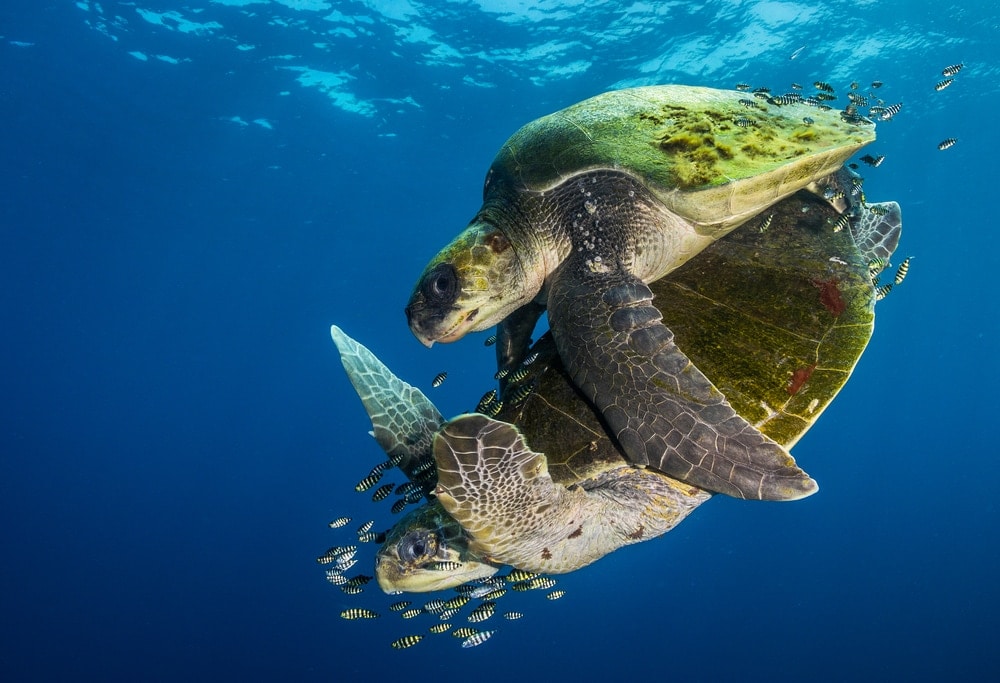
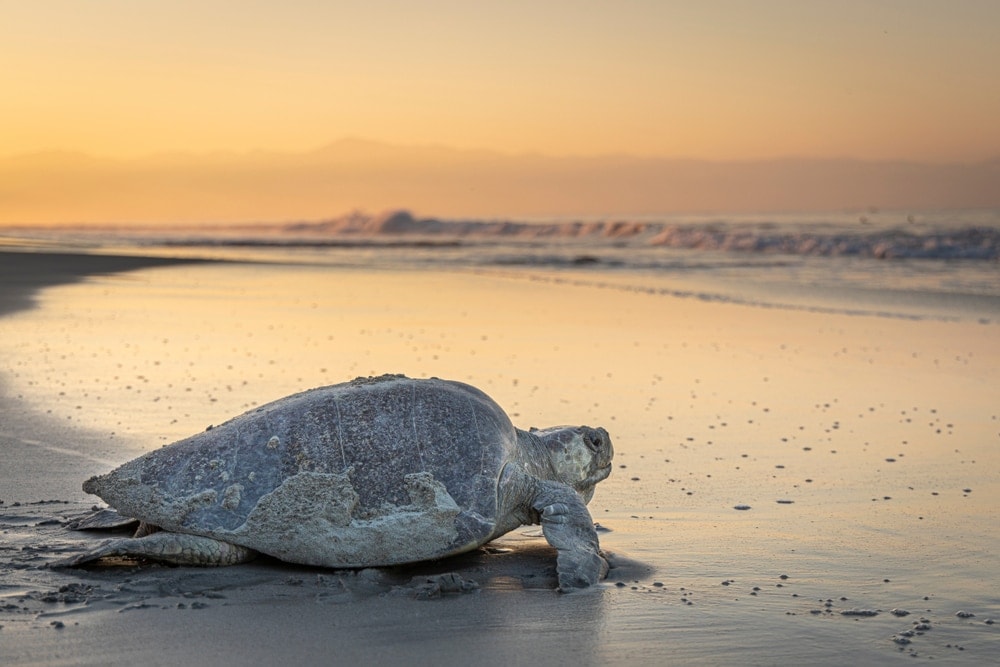
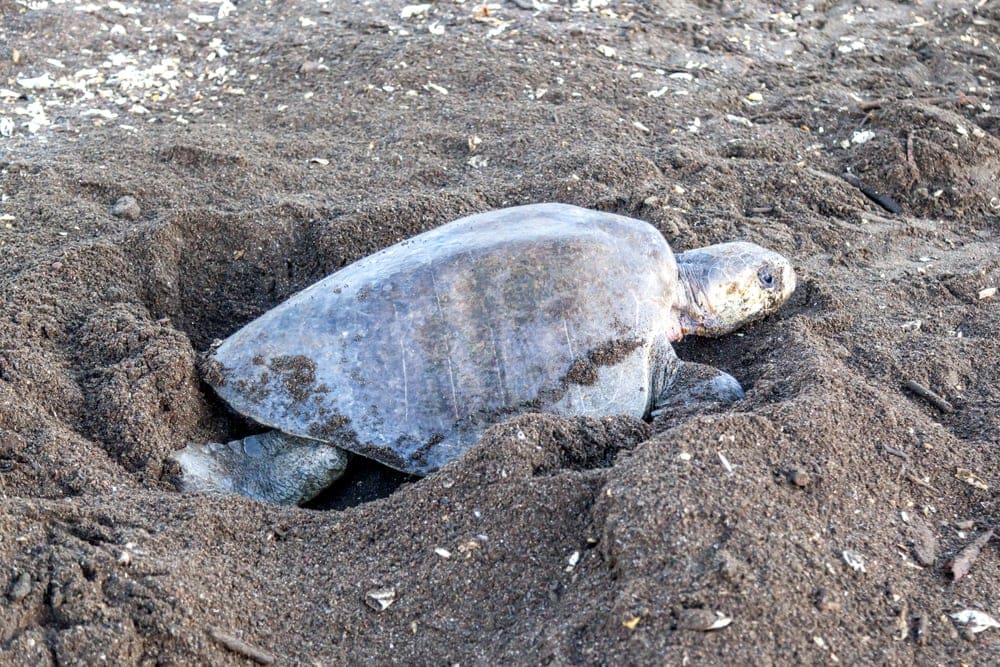
Last but not least, we have the olive ridley sea turtle (Lepidochelys olivacea). Also known as the Pacific ridley sea turtle, the olive ridley is the second-smallest of all the sea-dwelling turtles. It lives primarily in tropical waters in the Indo-Pacific, but there are some populations that live in the Atlantic, too.
The olive ridley gets its name from the greenish color of its carapace (the top of a turtle’s shell). It generally weighs no more than about 110 lbs (50 kg), but a hatchling can be as small as 0.82 oz (12 g).
Like the Kemp’s ridley sea turtle, the olive ridley has a fascinating synchronized nesting behavior. During the nesting season, thousands of female olive ridleys will return to the same beach at the same time to lay their eggs. This synchronized nesting is called arribadas and is one of the most amazing sights to see on a sandy beach at sunset.
These mass nesting sites are particularly attractive to predators, such as opossums, caimans, wild pigs, and raccoons. However, the olive ridley is listed as vulnerable by the IUCN primarily due to habitat loss and human disturbances.
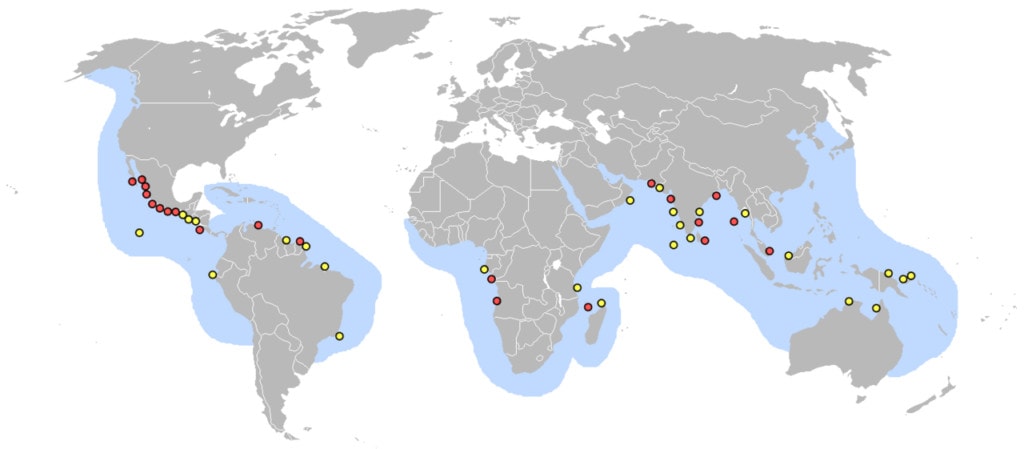
cc by-sa 3.0 / pinpin wikimedia commons
You may also like: 25 Dolphin Types: One of the Most Intelligent Marine Animals in the World with Cute Photos and Fun Facts
Sea Turtle Conservation Status & Threats
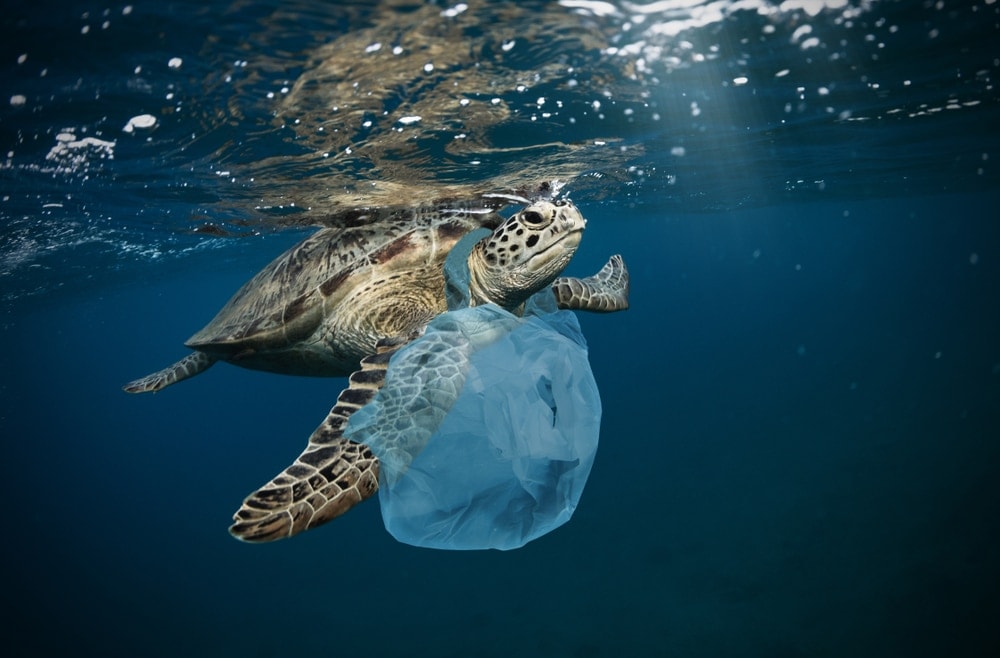
Every single one of the 7 types of sea turtles is listed either as vulnerable, endangered, or critically endangered (except 1 species that’s not well-studied). As a result, sea turtles are at a particularly high risk of extinction in the coming decades and centuries.
Although each of the 7 sea turtle species is unique, they generally share the same threats. These include:
- Habitat Loss – Sea turtles rely on sandy beaches for their nesting sites. The loss of sandy beaches to human development, particularly for waterfront properties, is a major issue for these marine reptiles.
- Oil & Gas Industry Impacts – Off-shore oil and gas drilling can disturb sea turtles around the world. However, oil spills are particularly harmful to marine wildlife—turtles included.
- Fishing Bycatch – Many sea turtles get accidentally trapped and killed inside commercial fishing nets that were intended for fish and shrimp.
- Predators & Disease – Sea turtles have few predators in adulthood, but they are very vulnerable to predators as hatchlings. There are also many diseases that can kill sea turtles, particularly in warmer waters.
- Marine Pollution – Plastic pollution, including from fishing nets, is a major threat to sea turtles. Turtles can eat plastic (especially plastic bags) and die as it gets stuck in their digestive systems. They can also get stuck inside fishing nets.
- Poaching & Hunting – Sea turtle hunting is banned in most countries, except for some limited subsistence hunting performed by Indigenous communities. But poaching is a big threat to sea turtles worldwide.
Thankfully, there are many organizations that work to protect sea turtles around the world. Many local governments also close down beaches during nesting season to help ensure that turtles have a safe and quiet place to lay their eggs without disturbances.
These organizations often need volunteers or donations to help with their efforts, so reach out to them to see how you can get involved!
5 Amazing Sea Turtle Fun Facts
Fancy yourself as a sea turtle expert? Here are some awesome sea turtle fun facts that you can use to impress your friends and family with your turtle knowledge:
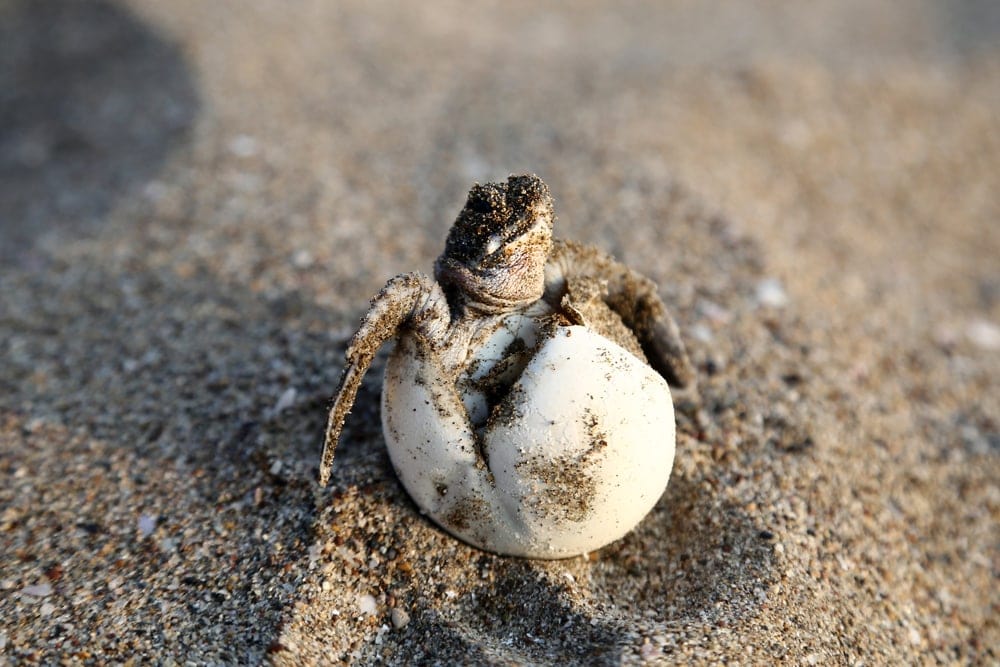
1| Sea Turtles Can’t Retract Into Their Shells
Yep, that’s right—unlike pretty much every other turtle species, sea turtles can’t retract their heads and flippers into their shells.
A sea turtle’s shell is an extension of its ribs that wraps fully around its body, sort of like an outer skeleton. However, sea turtle shells are made of bone, so they’re not the same as the exoskeleton that you see on insects, spiders, and other arthropods, which are made of chitin.
Since sea turtles can’t retract into their shells, they’re much more vulnerable to predators, especially on land. When in the water, a sea turtle’s excellent swimming ability can usually keep it safe from predation.
However, this inability to retract into their shells also means that sea turtles are at a higher risk for entanglement in marine debris and fishing nets. This is one of the reasons why accidental bycatch is one of the biggest threats to sea turtles around the world.
2| The Temperature Determines the Sex of a Sea Turtle
All sea turtles hatch from eggs that are laid in nests on beaches around the world. But unlike in many mammal species, where the biological sex of an individual is usually determined genetically at fertilization, the sex of a sea turtle is determined by the temperature.
Confused?
Research on sea turtle development in the egg shows that if the temperature surrounding an egg is below 81.86ºF, the turtle will be male. Alternatively, if the eggs are surrounded by temperatures above 87.8ºF, they will develop into females. If the temperature is between 81.86ºF and 87.8ºF, there will be a mix of female and male turtles.
This sort of temperature-dependent sex determination is actually fairly common in reptiles. It’s seen in crocodiles and alligators as well as in many types of snakes.
3| Sea Turtles Can Lay Hundreds of Eggs at Once
While we humans can usually only give birth to 1 or 2 babies at a time, sea turtles can have hundreds of young every time they lay eggs.
In fact, sea turtles lay an average of about 110 eggs in a single clutch (the number of eggs in a nest. That’s a lot of sea turtle babies!
What’s more, a sea turtle can have between 2 to 8 nests in a given season. So, in one mating season, a sea turtle can lay well over 800 eggs. This number is even higher for the hawksbill sea turtle, which can lay over 200 eggs in a single clutch.
Unfortunately, despite the fact that they lay a large number of eggs, not all baby sea turtles live to adulthood. Estimates vary widely, but research suggests that only 1 in 1,000 to 1 in 10,000 sea turtle babies make it to maturity.
Many baby sea turtles die during the treacherous crawl from the nest to the sea, where they’re at risk of predation by birds, foxes, crabs, and raccoons. As soon as they get into the water, many sea turtle hatchlings are also eaten by fish and seabirds. But, once they reach maturity, the sea turtle only has a few natural predators, most of which are large types of sharks.
4| A Sea Turtle Can Dive to Incredible Depths
It’s no secret that sea turtles are fantastic swimmers, but did you know that they’re accomplished divers, too?
Most sea turtle species can dive to at least 960 ft (290 m) below the ocean’s surface. Better yet, the leatherback sea turtle can actually dive to depths of more than 3,000 ft (1,000 m)!
Although all sea turtles are well-adapted to life in the water, the leatherback is particularly well suited for deep diving. That’s because leatherbacks have collapsible lungs that can help them withstand massive pressure changes. They also have flexible shells that are able to contract at deeper depths to reduce the pressure on a turtle’s body. Who knew?
5| Sea Turtles Can Live for More than a Century
Jonathan the Seychelles tortoise might have the record for the oldest-known land animal alive today at the age of 189. But, there could very well be some sea turtles in the ocean that can give Jonathan a run for his money.
Precise sea turtle lifespan estimates are hard to come by because it’s so difficult to study these amazing creatures in the wild. However, researchers believe that the average sea turtle can live to be between 50 and 100 years old—if it survives beyond the hatchling stage.
The lifespan of sea turtles in captivity is also tricky to pinpoint. But one of the oldest known sea turtles in the world is Myrtle, who’s currently living out her golden years at the Giant Ocean Tank at the New England Aquarium in Boston, Massachusetts. Experts at the aquarium estimate that Myrtle was between 90 and 95 years old in 2019.
You may also like: Everything You Need To Know About Different Types of Octopus
Sea Turtle FAQs
Here are our answers to some of your most commonly asked questions about sea turtles:
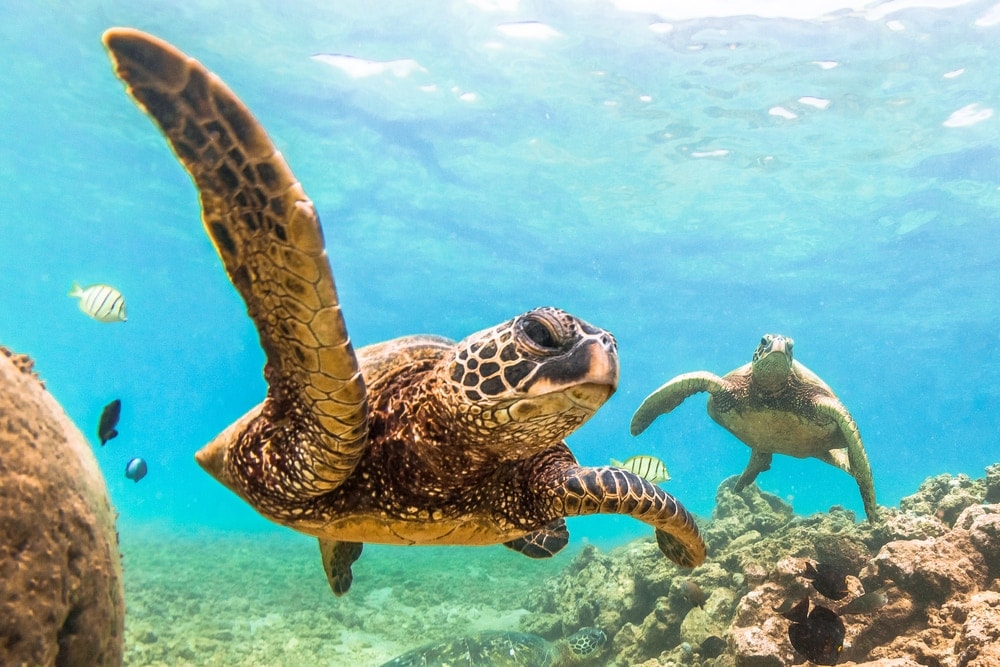
Why are sea turtles going extinct?
Sea turtles are in danger of extinction because of a number of causes, including habitat loss, pollution, climate change, and illegal poaching. Many sea turtles also end up as bycatch in shrimp trawling nets. For many sea turtle species, accidental bycatch is their biggest short-term threat.
What is the rarest sea turtle?
The rarest sea turtle species is the Kemp’s ridley sea turtle. There are no definitive species population numbers, but researchers believe that there are only 7,000 to 9,000 nesting female Kemp’s ridley sea turtles left in the world.
Which sea turtle is the biggest?
The leatherback sea turtle is the biggest sea turtle on the planet. It can grow to be up to 2,000 lbs (907 kg), or about the size of an adult walrus. Meanwhile, the smallest sea turtle is the Kemp’s ridley sea turtle, which is only about 100 lbs (45 kg) when fully grown.
What is a baby sea turtle called?
A baby sea turtle is called a hatchling. Baby sea turtles hatch from their eggs, which are laid in nests on sandy beaches. After a sea turtle hatches, it will slowly crawl its way to the ocean where it will live for most of its life.
How big do sea turtles get?
A giant sea turtle, which is actually a leatherback sea turtle, can grow to be up to 2,000 lbs (907 kg) in weight. These giant sea turtles can also be up to 8 feet (244 cm) long when fully grown.
Can I have a sea turtle as a pet?
It is illegal to have a sea turtle as a pet in most countries. They are illegal to keep as a pet in the United States because they are federally endangered. Additionally, most sea turtles grow to be way too big for the average home aquarium, making them impractical to keep as a pet.










